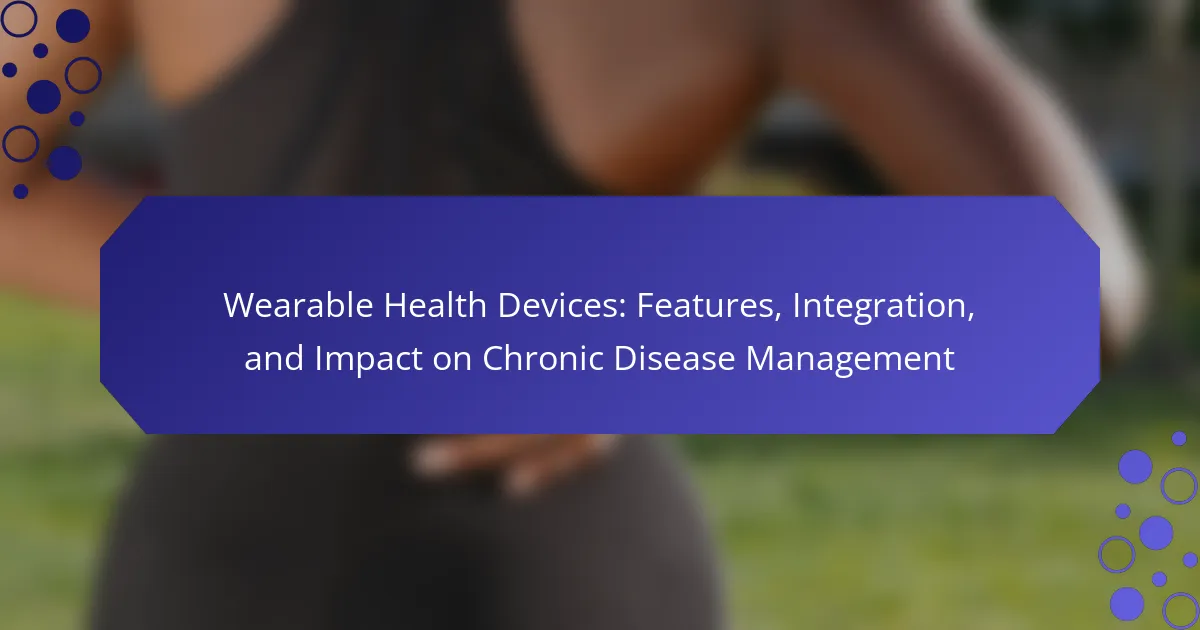Wearable health devices provide real-time monitoring, personalised insights, and enhanced communication, significantly improving chronic disease management. These devices track vital signs, medication adherence, and activity levels. Integration with smartphones and health apps facilitates timely interventions and empowers patients with actionable health data. Key features include heart rate monitoring, continuous glucose tracking, and user-friendly designs that promote consistent usage.
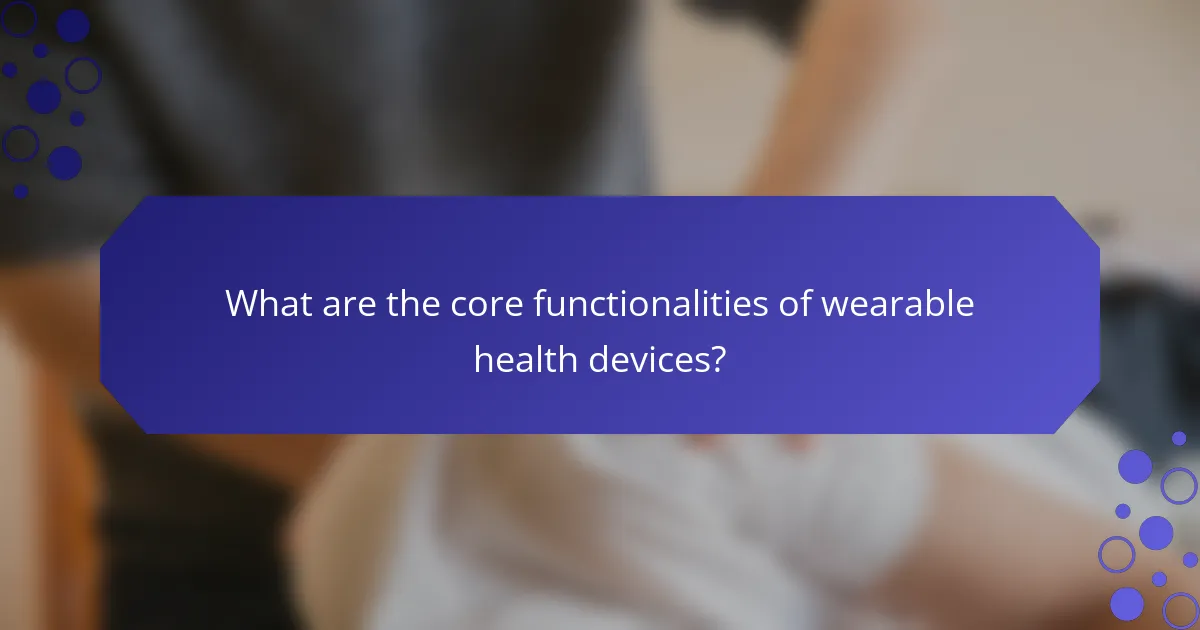
What are the core functionalities of wearable health devices?
Wearable health devices monitor vital signs, track physical activity, and provide real-time health data. They integrate with smartphones and health apps, enhancing chronic disease management. Key functionalities include heart rate monitoring, sleep tracking, and activity logging. The ability to collect continuous data supports personalised health insights, improving patient outcomes.
How do wearable health devices monitor vital signs?
Wearable health devices monitor vital signs through sensors that track physiological data in real-time. These devices utilise technologies like photoplethysmography, electrocardiography, and accelerometry to measure heart rate, blood pressure, and activity levels. Data collected is processed and transmitted to connected applications for analysis, enabling users to manage chronic conditions effectively. The integration of these devices into daily life promotes proactive health monitoring and timely medical interventions, significantly impacting chronic disease management.
What types of data do wearable health devices collect?
Wearable health devices collect various types of data, primarily focusing on health metrics. Common data points include heart rate, step count, sleep patterns, and calorie expenditure. Additionally, some devices monitor blood pressure, oxygen saturation, and stress levels. These metrics support chronic disease management by providing real-time insights into an individual’s health status.
How do wearable health devices integrate with mobile applications?
Wearable health devices integrate with mobile applications through Bluetooth connectivity, enabling real-time data synchronisation. This integration allows users to track health metrics, receive alerts, and manage chronic conditions effectively. Data from devices can be visualised in user-friendly interfaces, enhancing user engagement. Additionally, mobile applications often provide personalised insights, which can lead to improved health outcomes. These features support proactive management of chronic diseases, making wearables a valuable tool in modern healthcare.

What are the key benefits of using wearable health devices in chronic disease management?
Wearable health devices significantly enhance chronic disease management by providing real-time monitoring, personalised insights, and improved patient engagement. These devices track vital signs, medication adherence, and activity levels, enabling timely interventions.
1. Real-time monitoring: Continuous data collection allows for immediate detection of health fluctuations.
2. Personalised insights: Devices offer tailored feedback based on individual health patterns.
3. Enhanced communication: Integration with healthcare providers fosters better collaboration and care coordination.
4. Increased adherence: Reminders and alerts improve medication compliance and lifestyle changes.
5. Empowered patients: Users gain control over their health, leading to better self-management.
These benefits collectively contribute to more effective management of chronic conditions, improving overall health outcomes.
How do wearable health devices enhance patient engagement?
Wearable health devices significantly enhance patient engagement by providing real-time monitoring and personalised feedback. These devices empower patients to take an active role in managing their health, leading to improved adherence to treatment plans.
Features such as heart rate tracking, activity monitoring, and sleep analysis provide valuable insights into daily habits. Integration with mobile applications allows for seamless data sharing with healthcare providers, fostering better communication.
As a result, patients feel more connected to their health journey, which can lead to better health outcomes. Studies indicate that engaged patients are more likely to follow prescribed interventions, reducing hospital visits and improving chronic disease management.
What role do wearable health devices play in remote patient monitoring?
Wearable health devices significantly enhance remote patient monitoring by providing real-time health data. These devices track vital signs, activity levels, and other health metrics, enabling healthcare providers to monitor patients’ conditions remotely. This integration improves chronic disease management by facilitating timely interventions. For instance, continuous glucose monitors alert patients and providers about critical blood sugar levels, allowing for immediate action. As a result, wearable devices contribute to better health outcomes and increased patient engagement in their care.
How can wearable health devices improve medication adherence?
Wearable health devices enhance medication adherence through reminders, tracking features, and health data integration. They provide timely alerts for medication schedules, reducing missed doses. These devices can also monitor patient health metrics, offering insights that encourage adherence. A study found that users of wearable devices improved their adherence rates by up to 30%. Additionally, integration with healthcare providers allows for personalised feedback, further motivating patients to follow their medication regimens.

Which wearable health devices are most popular in 2025?
In 2025, the most popular wearable health devices include smartwatches, fitness trackers, smart clothing, and health monitoring patches. These devices enhance chronic disease management through advanced features like continuous glucose monitoring and heart rate tracking.
Smartwatches, such as the Apple Watch Series 9, offer health integration capabilities, including ECG and blood oxygen monitoring. Fitness trackers like the Fitbit Charge 6 focus on activity tracking and sleep analysis, promoting overall wellness.
Smart clothing, incorporating sensors, provides real-time data on vital signs and physical performance. Health monitoring patches, such as those from BioTelemetry, enable remote patient monitoring, ensuring timely interventions.
These devices significantly impact chronic disease management by empowering users with actionable health insights, improving adherence to treatment plans, and facilitating communication with healthcare providers.
What are the unique features of leading brands like Fitbit and Apple Watch?
Fitbit and Apple Watch offer unique features that enhance user experience and health monitoring. Fitbit emphasises fitness tracking with advanced metrics like heart rate variability and sleep analysis, while Apple Watch integrates seamlessly with iOS, providing notifications and app access. Both devices support health tracking for chronic disease management, but Apple Watch includes an ECG feature that detects irregular heart rhythms. Additionally, Fitbit devices often focus on battery life, boasting up to seven days on a single charge, compared to Apple Watch’s shorter duration. These distinctions highlight how each brand caters to specific user needs in wearable health technology.
How do regional preferences influence the choice of wearable health devices?
Regional preferences significantly shape the choice of wearable health devices by influencing design, features, and functionalities. Cultural attitudes towards health, technology adoption rates, and local health issues drive consumer preferences. For instance, regions with high chronic disease prevalence may prioritise devices that monitor specific health metrics. Additionally, language and user interface design can vary to cater to local demographics, enhancing user experience. As a result, manufacturers often customise devices to align with regional needs, ensuring better engagement and effectiveness in chronic disease management.
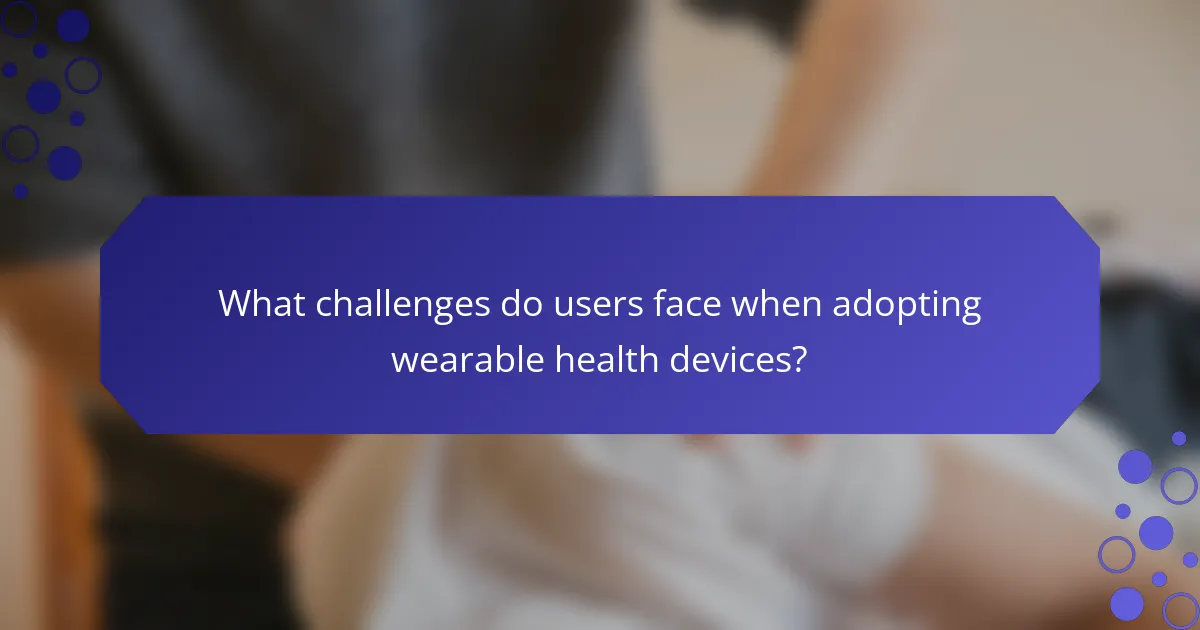
What challenges do users face when adopting wearable health devices?
Users face several challenges when adopting wearable health devices, including data privacy concerns, device accuracy issues, and integration with existing health systems. Many users struggle with understanding the technology and navigating user interfaces. Additionally, the cost of devices can be a barrier for some individuals. Compatibility with other health applications and devices also poses challenges, limiting the full potential of wearable technology in chronic disease management.
How do privacy concerns impact the use of wearable health devices?
Privacy concerns significantly impact the use of wearable health devices by influencing user trust and adoption rates. Many users worry about data security, leading to reluctance in sharing personal health information. The potential for data breaches and misuse of sensitive information can deter individuals from utilising these devices, ultimately affecting their effectiveness in chronic disease management. Moreover, regulatory compliance and transparency about data handling practices are crucial for fostering user confidence. As a result, addressing privacy issues is essential for the successful integration of wearable health devices into healthcare systems.
What technical limitations do wearable health devices currently have?
Wearable health devices currently face several technical limitations. These include battery life constraints, limited data accuracy, insufficient integration with healthcare systems, and challenges in user interface design.
Battery life often restricts continuous monitoring, with most devices requiring daily or weekly charging. Data accuracy can vary significantly, influenced by sensor quality and environmental factors. Integration with healthcare systems remains inadequate, making it difficult for users to share data with healthcare providers seamlessly. Lastly, user interface design can complicate usability, especially for older adults or those unfamiliar with technology.
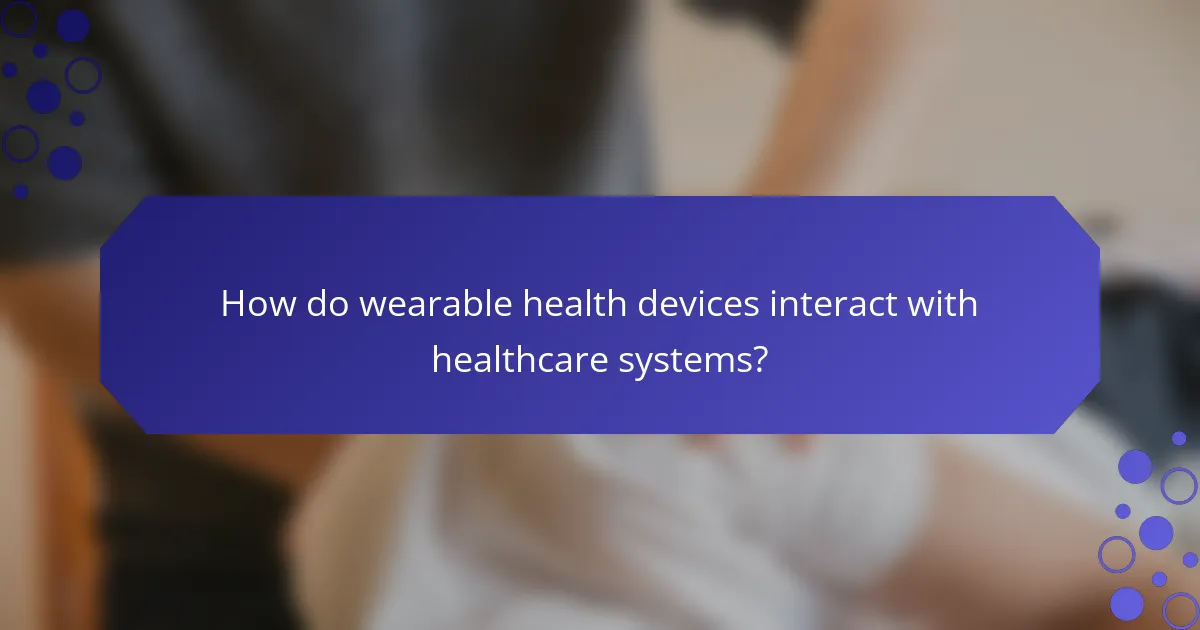
How do wearable health devices interact with healthcare systems?
Wearable health devices enhance healthcare systems by enabling real-time data sharing. These devices monitor vital signs, track activity levels, and facilitate communication between patients and providers. As a result, healthcare professionals can make informed decisions and personalise treatment plans based on accurate data. Integration with electronic health records (EHR) allows seamless access to patient information, improving chronic disease management. Wearable devices can also alert healthcare providers to potential issues, fostering proactive interventions and reducing hospitalisations.
What are the integration challenges between wearable health devices and electronic health records?
Integration challenges between wearable health devices and electronic health records include data interoperability, user privacy concerns, and inconsistent data formats. These issues hinder seamless communication and accurate patient monitoring. For example, varying standards across devices can lead to discrepancies in health data, complicating care coordination. Addressing these challenges is crucial for enhancing chronic disease management through effective data integration.
How can healthcare providers leverage data from wearable health devices?
Healthcare providers can leverage data from wearable health devices to enhance patient monitoring and personalise treatment plans. These devices track vital signs and activity levels, providing real-time insights into patient health. This data can improve chronic disease management by enabling timely interventions and reducing hospital visits. For example, continuous glucose monitoring devices help diabetic patients manage their condition more effectively by alerting providers to critical changes. Integrating this data into electronic health records enhances care coordination and supports evidence-based decision-making.

What are the emerging trends in wearable health device technology?
Wearable health device technology is increasingly focused on personalised health monitoring, advanced data analytics, and seamless integration with healthcare systems. These trends enhance chronic disease management by providing real-time health insights and enabling proactive interventions.
The rise of artificial intelligence in wearables allows for more accurate health predictions and tailored fitness plans. Devices are also incorporating features like continuous glucose monitoring and heart rate variability analysis, which are essential for managing conditions like diabetes and cardiovascular diseases.
Furthermore, interoperability among devices is improving, allowing users to consolidate data across various platforms. This integration empowers healthcare providers with comprehensive patient data for better decision-making.
Finally, the emphasis on user-friendly designs and wearable comfort is growing, ensuring that patients are more likely to use these devices consistently, thus maximising their potential benefits in chronic disease management.
How are advancements in AI shaping the future of wearable health devices?
Advancements in AI are significantly enhancing wearable health devices by improving data accuracy and predictive analytics. These technologies enable continuous monitoring of vital signs, leading to better chronic disease management. AI algorithms analyse data patterns, allowing for personalised health insights and timely interventions. For instance, AI can predict potential health issues before they arise, enhancing patient outcomes and reducing healthcare costs.
What innovative features are expected in next-generation wearable health devices?
Next-generation wearable health devices are expected to feature advanced biometric monitoring, AI-driven health insights, and seamless integration with telehealth platforms. These innovations will enhance chronic disease management by providing real-time data analysis and personalised health recommendations.
Innovative features include continuous glucose monitoring for diabetes management, ECG capabilities for cardiovascular health, and stress management tools using biometric feedback. These devices will likely leverage machine learning algorithms to predict health events, offering users proactive health management. Enhanced battery life and improved user interfaces will also contribute to a more user-friendly experience.
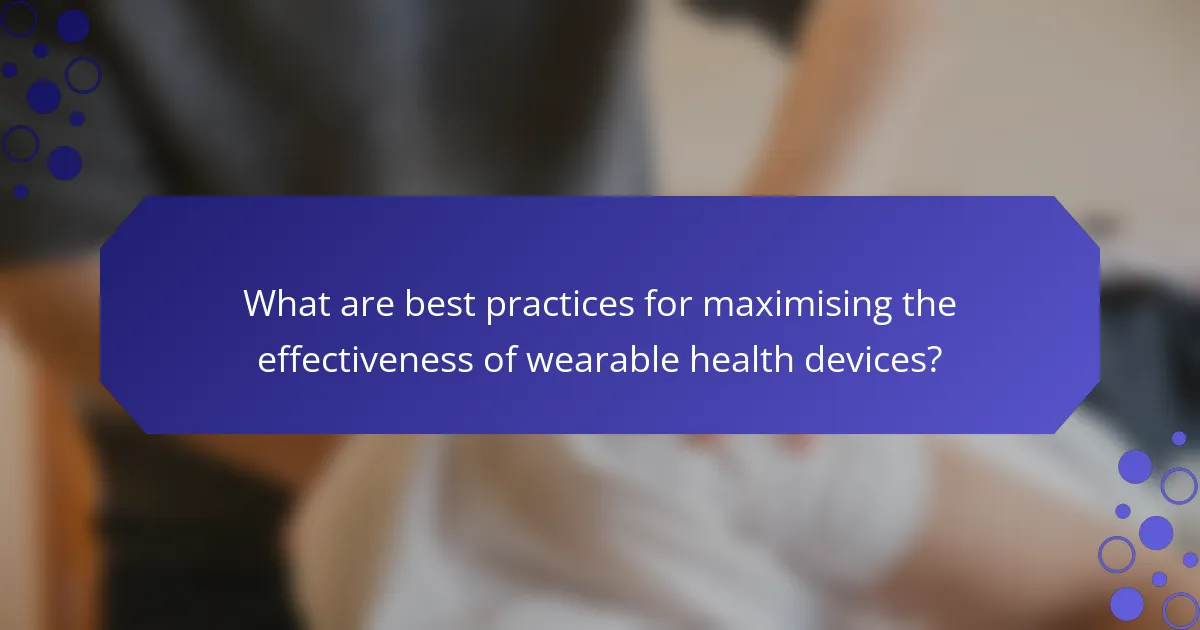
What are best practices for maximising the effectiveness of wearable health devices?
To maximise the effectiveness of wearable health devices, users should focus on proper integration, consistent usage, and data analysis. Regularly syncing devices with health apps enhances data accuracy and accessibility. Setting clear health goals encourages motivation and adherence. Engaging with community features fosters accountability and support. Lastly, reviewing and interpreting collected data helps users make informed health decisions.
How can users ensure accurate data collection from their wearable health devices?
To ensure accurate data collection from wearable health devices, users should regularly calibrate their devices, maintain a consistent wearing schedule, and ensure proper sensor placement. Calibration helps align device readings with medical standards. Consistent use allows for better data trends and insights. Proper placement ensures sensors can effectively capture relevant health metrics.
What common mistakes should users avoid when using wearable health devices?
Users should avoid common mistakes like neglecting device calibration, ignoring data privacy settings, and failing to integrate health insights into their routines. Misunderstanding metrics and over-reliance on technology can hinder effective chronic disease management. Regularly updating the device and engaging with app features enhance user experience and health outcomes.
